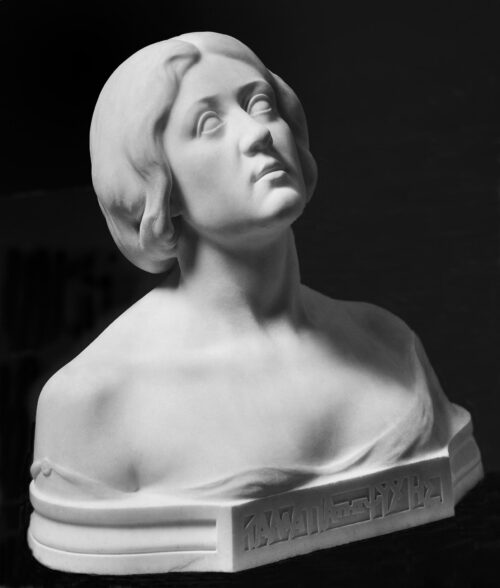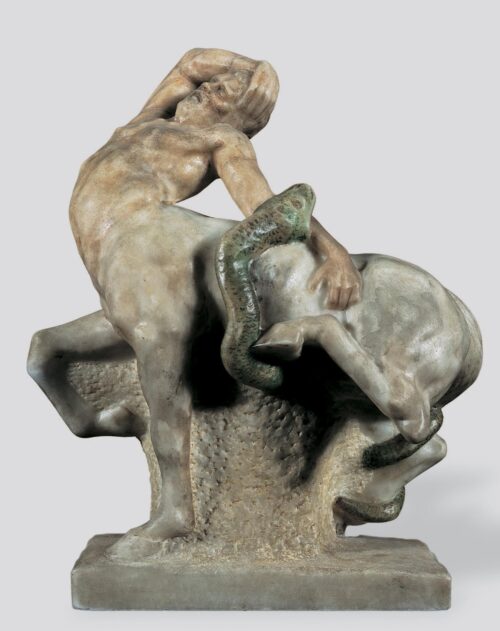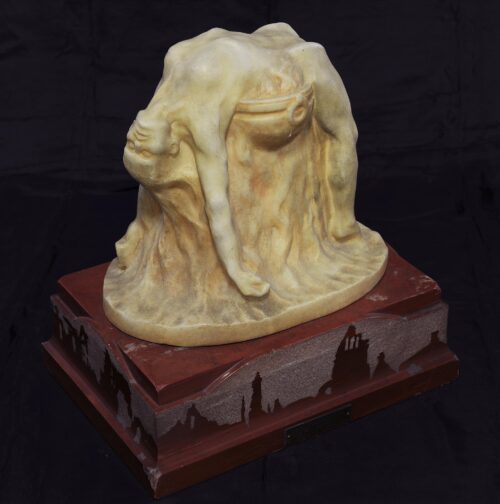Thomas Thomopoulos (1873 - 1937)
Thomas Thomopoulos was a sculptor, painter and academic. He was born in Smyrna in 1873. He settled in Athens in 1877 and after his encyclical studies he attended classes at the School of Arts under the teacher Georgios Brutos in sculpture and Nikiforos Lytras in painting.
In 1897 he won the Thomaidio and the Chrysovergio prize, as well as a scholarship to study abroad. He then went to Munich, where he studied at the Academy of Fine Arts and later continued in Florence, Naples and Rome. In 1900 he returned to Athens and opened his own workshop.
In the same year, he succeeded G. Bonanno in the chair of sculpture at the School of Fine Arts, where he remained until his death. Thomopoulos' work is influenced by German and Italian currents.
In January 1912 he was appointed professor at the School of Arts and held this position until his death. His contribution to saving the work of Giannoulis Halepas was particularly important, as in 1922, as the head of a crew of the Ministry of Education, he went to Tinos and transferred the works of the last period of the Tinian sculptor into plaster. In 1930 he was elected a regular member of the Academy of Athens.
His exhibition activity includes individual and group exhibitions, among which are exhibitions of Parnassos and the Hellenic Artistic Society, as well as the Venice Biennale in 1934, while his works were presented with honor at the Panhellenic Exhibition of 1948.
The classicist elements of his work are due to his apprenticeship under Georgios Brutos, while already from his first creations, with his preference for mythological and allegorical themes, neo-idealist and symbolist tendencies with which he had come into contact during the of his studies in Munich. However, Thomopoulos is not limited to them, as his entire artistic creation is characterized by an eclectic mood. Thus, romantic elements can be distinguished, such as the pursuit of rendering passion or the liquidation of contours that has its starting point in Rodin, as well as realistic elements, mainly in his busts. His greatest innovation was colored sculptures, which he introduced from about 1900.
He played an important role (along with other artists) in the artistic recognition and life of Giannoulis Halepas in the mid-1920s.
He created many busts of Th. Deligiannis, Emm. Xanthos, Dion. Solomos in the National Garden, of Papadiamantis, statues such as those of X. Trikoupis, the monument of the Unknown Soldier and other burial monuments. He presented his sculptures in Greece and abroad. He died in Athens in 1937.
Works
He created many busts and statues. Well-known works by Thomopoulos can be found in central parts of Athens but also in other parts of Greece:
Bust of Dionysios Solomos in the National Garden (1924)
Bust of Emmanuel Xanthos, in Kolonaki square
Andriantas by Harilaos Trikoupis in front of the Old Parliament.
He had initially collaborated on the monument to the Unknown Soldier in the Greek Parliament with Manolis Lazaridis which was finally commissioned and designed by the sculptor Phokionas Rok.
The Statue of Liberty in Prophet Ilias Chania.
Paintings & Sculptures
And many others such as "|The Tower of Leander in Constantinople, Oil painting on canvas, 19 x 36 cm., Private Collection", or the statue of Dionysius Solomon, Athens - National Garden
According to Ilias Mykoniatis, Thomopoulos attempts with his sculptures to project ideas and symbols for the creation of a national art, but technically he does not succeed in going beyond the general rule of classicism in an academic idiom and, in fact, with harsh elements, which reach to discredited from an aesthetic point of view (indicatively, Pericles Giannopoulos, Greek Line, 1903). In the same direction, Efthymia Mavromichalis points out that, although in his article the sculptor criticizes academicism and envisions a new national art, inspired by modern reality, his work is not consistent with his intentions, as a result of which he appears contradictory .
More generally, Thomopoulos' sculpture represents the culmination of the transitional period from academic classicism and idealism to academic realism, with influences from symbolism and romanticism.







Σχόλια